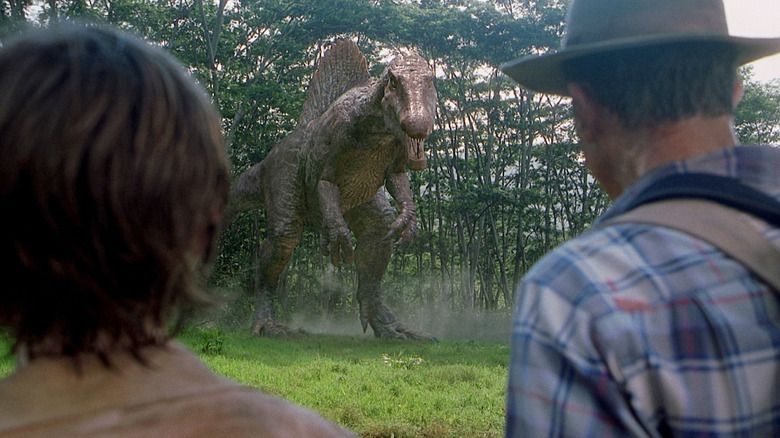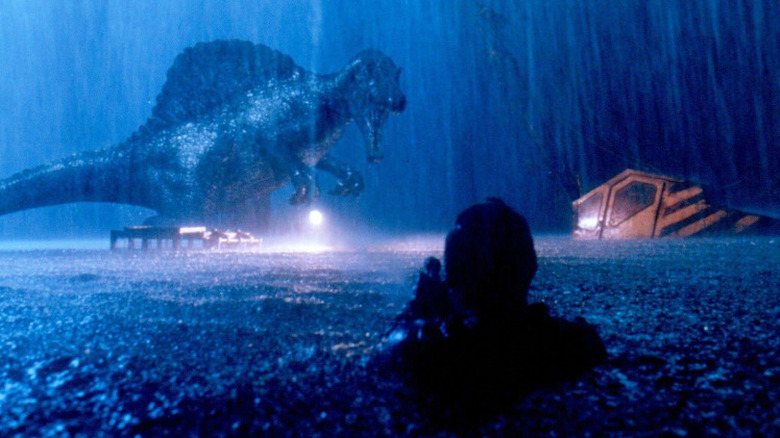How Jurassic Park III Created The Roar Of The Spinosaurus
Few moments in "Jurassic Park" film history have ruffled feathers — and not of the dinosaur variety — quite like the scene where a Spinosaurus fights and kills a Tyrannosaurus rex in "Jurassic Park III." This was meant to be a way of announcing the Spinosaurus as the next Big Bad of the franchise, a carnivore so powerful even the T-rex couldn't defeat it. Years later, though, many people remain firmly Team Tyrannosaurus when it comes to the reigning champ among meat-eating dinos.
Be you Team Tyrannosaurus or Team Spinosaurus (or maybe you're Team Indoraptor, I'm not here to judge), "Jurassic Park III" does a fine job of bringing both dinosaurs to life using a blend of convincing animatronics and CGI. But it's not just the visuals that sell them; it's the sounds they produce that make you really believe these are living, breathing creatures on the lookout for a tasty human sandwich. Actually creating the roars for these extinct reptiles is no small task, either, as "Jurassic Park III" sound designer/re-recording mixer Christopher Boyes can tell you.
As part of a bonus feature included with "Jurassic Park III" on Blu-ray and digital, Boyes explained that big cats formed the basis for the Spinosaurus' roar:
"I got in contact with a fellow by the name of Ron Whitfield. He's a well-known big cat breeder, and he has a retired cat's home in the middle of nowhere. We were able to go to his site and record these big lions and tigers (some of which weighed in excess of 300 pounds), which played as a very strong element in the Spinosaurus for instance."
Lions and alligators and bears, oh my!
The process of generating the Spinosaurus' earth-shaking bellow, as with the procedure for producing the sounds uttered by any dinosaur, went well beyond merely recording big cats and amplifying their roars. Speaking on the same bonus feature, Christopher Boyes said it took a mixture of animals noises to create the final product heard in "Jurassic Park III," all of which had to come together to form a unique sound that, to his ear, seemed befitting of a creature that could tussle with a T-Rex and live to tell the tale. Boyes explained:
"In the case of the Spinosaurus, I would use the low guttural quality of both a lion and an alligator, and I used the sound of a baby bear crying, and then I lengthened a big bird cry that had a raspy quality. It's almost like, you know, you sandwich these together, and then you start playing with them back and forth and figuring out how the components go together."
"Jurassic Park III" might have been the worst-reviewed entry in the "Jurassic Park" film trilogy, but it's always had its defenders and has only seen its reputation improve since it came out in 2001. Whether you agree with the reappraisal or not, there's no denying the artistry that went into realizing its prehistoric wonders, not least of all the sound design (an aspect of cinema that remains woefully under-appreciated across the movie industry to this day).

